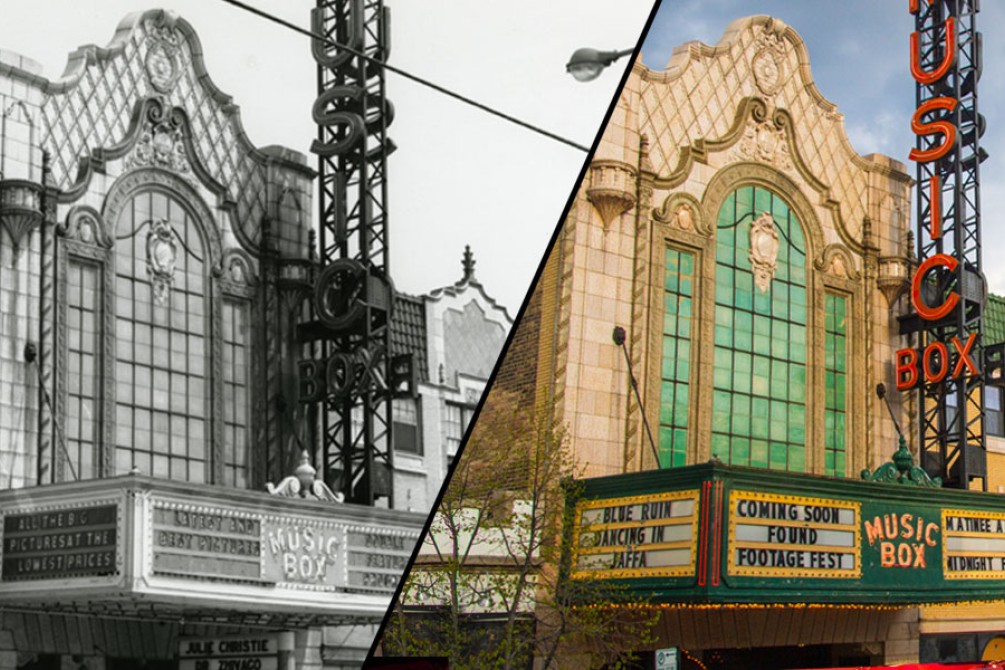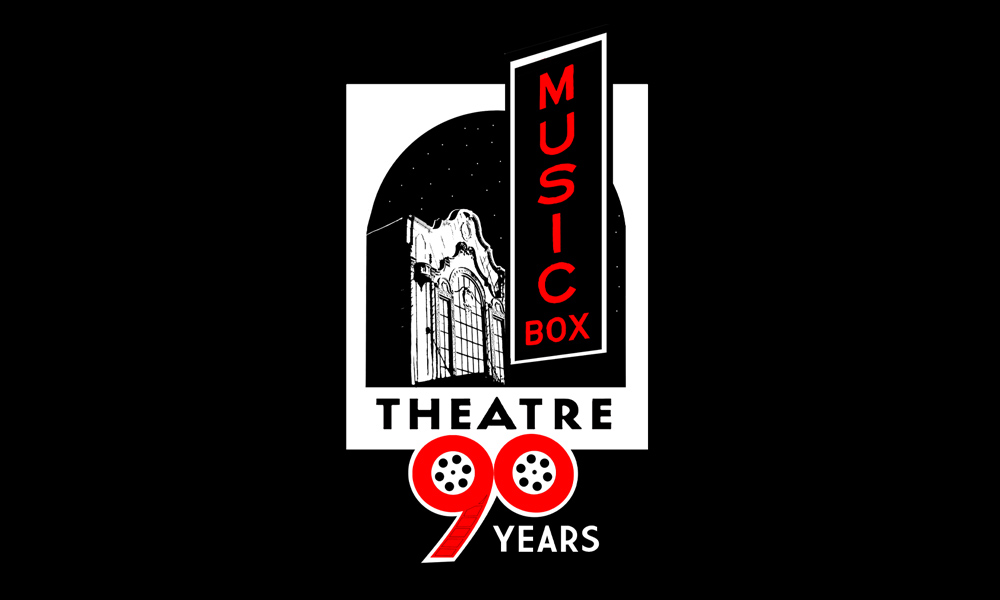CLICK HERE to view our 90th Anniversary Programming
August 2019
—by Bill Stamets
The 90th anniversary of the Music Box Theatre offers a prism on its past as a neighborhood movie palace.
From its namesake musical device to 70mm spectacles, the Music Box embraces a gamut of film genres, along with guest appearances and sing-a-longs. Its narrative frames the bigger picture of cinema in Chicagoland.
The Music Box Theatre opened on August 22, 1929. M. J. Schmidt, automobile dealer and president of the Blaine Building Corporation, was the builder; the architects were Louis I. Simon and Edward Steinborn; and the first owner-operator was Jacob Lasker, who would later run six other movie houses with his two sons.
Opening weekend aligned with the fourth annual Southport Business Men’s Association festival. “There will be a parade… and dancing every night at M. J. Schmidt auto salesroom, 3722 Southport,” promises a local notice. Ballyhoo included six appearances by Miss Chicago of 1929. The 17-year-old fireman’s daughter went on to represent Illinois at International Pageant of Pulchritude.
“Present tendencies in theatre construction make a new theatre in Chicago, the Music Box, one of the most interesting to be found,” reports Exhibitors Herald-World. “It is to a large degree representative of a whole class of motion picture theatre buildings which is growing larger and larger and which we may expect will be the dominant one in the United States within relatively a very short time… The house was especially designed for sound.”
Possibly the first movie theater built in Chicago to only present sound films, the Music Box was built with a base in the floor for a theater organ. None was in place until 1984, though. Flanking the proscenium are two more vestiges of the silent-era: chambers for organ pipes that were never installed.
The Music Box did not book live acts to accompany its screen fare, as did other exhibitors in the transition to talkies. Exceptions include “Added Attraction– Chief Red Fox and His Oklahoma Indians in Person” on April 2, 1933. The feature was “Hello, Everybody” starring Kate Smith.
Nowadays the shallow stage accommodates filmmakers making appearances. The roster includes Wes Anderson, Crispin Glover, Tipi Hedron, David Lynch, Eva Marie Saint, Paul Schrader, Agnes Varda, Haskell Wexler and Kristin Wiig.
This neighborhood-scale palace is “atmospheric” in design. Chicago Tribune architecture critic Paul Gapp once called it “an eclectic melange of Italian, Spanish and Pardon-My-Fantasy.” The ceiling sports twinkling star-like lights and passing cloud effects, touches found in some other theaters of the era.
“Mother’s Boy,” starring an `all-talking, all-singing’ Morton Downey, was the first picture to pass through the Simplex projectors and Western Electric sound system. “A Story of Romance and Sentiment Tunefully Told,” plugs Pathé. Two months earlier the Chicago Tribune critic gave that feature just one star when it played at the State-Lake in the loop. When that 2,649-seat theater opened in 1919 it advertised “Continuous Double Value Vaudeville and Photoplays at Single Prices.”
Our north side 748-seater did not compete for first-run fare with the Balaban & Katz chain, which by 1929 had 17 theaters with a total of 46,057 seats. Second-run and third-run features were the typical fare the Music Box advertised in the Chicago Tribune. That year Variety cited a 1917 interview where A. J. Balaban declares that “show business will not be conducted by showmen but by business men; amusement is a business and the future of that business lies in business hands.”
Double features at the Music Box began in December 1929. Ads tout “All Talking” films as late as October 1930. Rarely mentioned are triple bills. Kidds saw the serials “The Indians Are Coming,” “Rin Tin Tin” and “Tarzan the Fearless.” From 1929 onwards “adults-only” shows included: “Fast Life,” “Divorcee,” “Her Unborn Child,” “Blonde in Bondage,” “Too Bad, She’s Bad,” “Clockwork Orange,” and “Oh! Calcutta.” Summertime ads would add: “Cooled Sensibly with Washed Air.”
The Tribune also ran display ads for Special Showings that name the Music Box alongside other places presenting the same film. "The Blue Max" opened at the Music Box and at 17 city and suburban theaters in January 1967. "The Christmas That Almost Wasn't" screened there and at 27 other venues in December 1967.
In 1977 and 1978 “1st-run Chicagoland” ads list the Music Box with assorted city, suburban and Indiana theaters and drive-ins all showing “Avalanche,” “Black Sunday,” “Count Blacula and his Vampire Bride,” "Dogs" (“They’re Here.”), “Jaws II,” “Orca, the Killer Whale,” “Piranha,” “Rabid” (“You can't trust your mother… your best friend… the neighbor next door.”), “Rattlers” and "Warlords of Atlantis.”
The last such Tribune ad for a film at the Music Box ran on July 16, 1978. That was for “Damien Omen II.” Until the theater’s renaissance five years later, there is no trace in local newspaper archives of what was publicized. Spanish-language films apparently screened there; the owner in the early 1980s was from Colombia. A student at St. Rita High School at the time, Tim O’Neill recalls seeing flyers for Arabic-language films at the Music Box. He later worked there as a projectionist.
“Classic American Films in Chicago’s only restored neighborhood Movie Palace” announces the ad when the Music Box reopened on August 5, 1983. Few of those screen gems likely graced its screen when released. Debut retro series were “Hollywood Looks at Hollywood!” and “The Legendary Leading Ladies.” Leasing the theater for the next 20 years, partners Christopher Carlo and Robert Chaney diversified the calendar with revival, repertory, art house and independent fare.
First-run foreign films increase. The kind that owner William Schopf relished as a Kenilworth kid tuning in “Cinema 9,” WGN-TV’s Sunday 10:15 p.m. film series, and patronizing his local Teatro del Lago cinema. In 1986 this commercial litigator bought the Music Box property, which includes 34 apartments and 8 stores.
Schopf restored the vintage marquee, installed a 75-seat theater, and added a lounge next to the lobby that serves Music Box Matinee Red and Music Box Box Office Blush from Schopf’s vineyard in Baroda, Michigan. The line-up of events in the space– decorated with shelves of film books– includes a book-signing by Chicago film critic J.R. Jones, author of The Lives of Robert Ryan (Wesleyan University Press.) Lower-brow and brew-centric is the Monthly Music Box Drink-A-Long: “Do you like movies? Do you like drinking? Do you like rules?”
Seasonal sing-a-longs– a throwback to community sings once popular in variety and movie houses– include the Christmas double-feature Sing-a-Long, a holiday tradition dating from 1983. For Thanksgiving there’s “The Sound of Music” with lyrics projected onscreen, an update on illustrated song slides. Midnight screenings of the “Rocky Horror Picture Show” are an audience-interactive Halloween tradition that evokes the midnight spook shows from the late thirties.
Different styles of dark turn up at Cinepocalypse, a week-long horror fest, and Noir City Chicago, a yearly series co-presented by the Film Noir Foundation Film in San Francisco.
Silent films– the likes of which never screened at the original Music Box– are now a fixture co-presented by The Chicago Film Society and accompanied by a house organist. This Silent Cinema Series often accesses prints from film archives.
The Music Box bills itself as “Chicago’s year-round festival.” Besides hosting the Chicago Critics Film Festival, it served as one of the venues for both the Chicago Lesbian and Gay Film Festival and the Chicago International Film Festival.
The signature event for the theatre’s brand would be the annual 70MM Film Festival for projection connoisseurs. Even as we over-watch on our personal screens, devolving to the single-viewership of the Kinetoscope, circa 1894.
Trending with digital delivery, Schopfs launched a subscription streaming service labeled Music Box Direct in April 2019. Back in 2007 he created Music Box Films to serve “the viewing interests of sophisticated US movie audiences,” to quote its Facebook page.
August 1929 audiences viewed movies with interests unlike our own. On the screen at 3733 N. Southport they read neither intertitles nor subtitles, let alone reviews on the internet.
On its 90th anniversary this neighborhood playhouse– there are rentals for movie-themed kids parties– revives a film society ethos. An epicenter for cineastes devoted to the big-screen experience.
“The neighborhood theater… should be the ideal meeting house of intelligent people, their club, their house of social harmony,” urges Louis Reeves Harrison in Moving Picture World in 1918.
“The building of neighborhood houses in residential districts started in Chicago and Los Angeles and soon spread over the country,” records Benjamin Hampton in A History of the Movies, published in 1931 during the Depression, two years after the original Music Box opened.
Industry insider Hampton ends brightly: “… the American people– and large sections of the public in other lands– have learned to enjoy theaters more than any other form of amusement, entertainment, or mental recreation. They like to be part of a crowd at a theater. As long as our present form of civilization continues these desires and habits will endure.”


